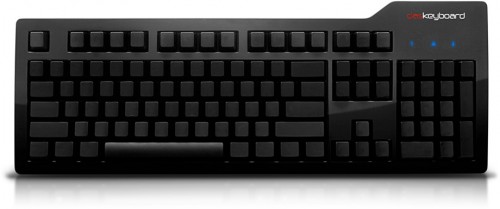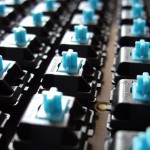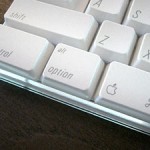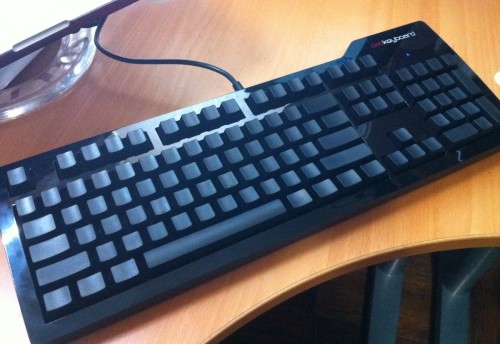 When I got home from the road, I was determined to celebrate having a desk. As in, having the same desk every day, not something that passes for a desk in a hotel room or on a bus. The first way I went about celebrating was to research buying a new keyboard for my laptop. I want to give my laptop more of a desktop-like experience when plugged in at home, with a real keyboard and mouse, and multiple monitors.
When I got home from the road, I was determined to celebrate having a desk. As in, having the same desk every day, not something that passes for a desk in a hotel room or on a bus. The first way I went about celebrating was to research buying a new keyboard for my laptop. I want to give my laptop more of a desktop-like experience when plugged in at home, with a real keyboard and mouse, and multiple monitors.
What I have
I have a gaming keyboard (one of the original G15s from Logitech) which is connected to my PC, but when it comes to other keyboards in my household, I have an old and broken Apple Pro Keyboard in graphite somewhere in the bottom of my closet, a slightly less-old and not-broken Apple Pro Keyboard in white, and some crappy miniature backlit keyboard that I found on sale for $20 on the road three years ago. Aside from the G15, none of these are what could be called pleasant to type on. The G15 is decent, but it was needed for gaming, and I’ve always thought if ever I got the hell off the road, I wanted a really nice mechanical keyboard, one that would be geared towards writing, not for gaming.
Keyboard snobbery
While not as rabid as some fans, I did grow up typing on the old IBM Model M keyboards, so I did feel some nostalgia towards mechanical keyboards, although I definitely did not want a Model M replica (which are still made by Unicomp, and can be seen here).
The first thing I want to say about keyboard snobbery is that if you feel you may take keyboards a little too seriously, you need to head on over to geekhack.org. There you will find a forum filled with people who know everything about every kind of keyboard out there. I learned much in just a few days of lurking. They also sell and trade obscure keyboards and parts, and there are wikis and reviews with more information, too.
Two other forums I’ve found with some good info are at Overclock.net (especially The Mechanical Keyboard Guide, which is a great resource for beginners trying to choose a keyboard), and HardForum.com which has more opinions and reviews.
 Probably the first decision you have to make when choosing a mechanical keyboard is what kind of switches you want. The most common and cost-effective ones are made by Cherry, and are designated by the color of the plastic used for the top of the switch, which indicates the design of the internals. That guide I posted above from Overclock demonstrates the differences between each color. I should also mention that when I say “cost-effective,” bear in mind that mechanical keyboards are expensive. That’s why hardly anybody makes them anymore. They’re pretty much always going to be over $100, and the ones that use better switches than Cherry are usually going to be over $200.
Probably the first decision you have to make when choosing a mechanical keyboard is what kind of switches you want. The most common and cost-effective ones are made by Cherry, and are designated by the color of the plastic used for the top of the switch, which indicates the design of the internals. That guide I posted above from Overclock demonstrates the differences between each color. I should also mention that when I say “cost-effective,” bear in mind that mechanical keyboards are expensive. That’s why hardly anybody makes them anymore. They’re pretty much always going to be over $100, and the ones that use better switches than Cherry are usually going to be over $200.
When first researching, I was thinking I was interested in Cherry blues, which are recommended for typing (not so much for gaming), and have that nice loud, annoying click sound that mechanical keyboards were originally known for. They are highly not recommended if you plan to use your keyboard at work or in a home where other people will be able to hear you clacking away. But since I live alone and planned to keep my keyboard at home, I thought I would revel in the satisfying click of every letter I typed.
Slightly more popular than blues are Cherry browns, which are similar to the blues, but without the click. The thing people like about the blues is that they have an audible and tactile indication of when the keypress registers (which is about halfway through the press, not when it bottoms out). The browns have only a tactile bump, and no sound. That’s not to say they’re totally silent, but they don’t purposely produce noise. If you were really trying to type quietly, you can do it as well or maybe even better than you could on any other keyboard. But if you’re typing vigorously, you do get a heart-warming clickity-clack from pressing the keys down if you bottom out, and the noise of the key bouncing back up.
Trying it out
One of the few mechanical keyboards easily available in the US is the Das Keyboard, which was originally famous for having no markings at all on its keys — just a sea of blank black keys. These days they also sell a model that has letters printed on it, but I didn’t see the point of going halfway if you’re going to buy a badass keyboard.
At first this was what I thought I wanted — they sell both the printed and non-printed keyboards with blue or brown switches. But when I started to read reviews I got directed to the fine forums I mentioned above for recommendations of even higher-quality keyboards. I had a lot of choices to make.
While inspecting my options for purchase, I was looking at the Das on Amazon, and noticed the version I had put in my shopping cart was supplied by J&R Computers. And I was like, “reeeaaaalllly?” So I took a non-virtual shopping trip to J&R and played with both the blue- and brown-switched versions in person. I also came prepared with a thorough knowledge of their return policy (14 days), and a determination to buy a keyboard, whether I ended up liking it or not.
Decisions, Decisions
I went back and forth between the blue and the brown. The clicks of the blues were fun, but I found myself not really liking the feel of it. It’s very hard to tell in a store — I’ve never experienced a new keyboard that I liked typing on right away. But I found somehow the clicks were actually confusing and distracting me. I’m sure I would have figured it out, given enough practice. I also felt the slightly greater weight needed to depress the keys was making my fingers feel a little overworked. What really surprised me about the whole experience was not that I didn’t like the blues right away, but that I did like the browns. They didn’t feel mushy to me, they just felt like they would stay out of my way instead of making the experience of typing all about them. So I decided that since I wasn’t locked into my decision anyway, it might be the braver choice to take home the keyboard I thought I didn’t want, and make it prove to me that something was wrong with it. Also, in the back of my mind I was aware that the browns are more popular, and if I liked them I would have a wider range of options when looking at other models.
So I took home my Das Keyboard Ultimate Silent edition.
The Review
The first thing I’m going to say is that I’m not keeping it. It’s not that it’s a bad keyboard. I actually like it a lot. The real dealbreaker for me is that I don’t want the number pad. A bunch of other manufacturers offer a “tenkeyless” version, which is an otherwise full-size keyboard with the number pad lopped off. The idea being that if you don’t need a number pad you can slide the keyboard more to the right without pushing your mousepad miles away, which allows you to have the actual typing part of your keyboard more centered on your screen, and your mouse closer at hand, which just makes a whole lot of sense. The moment I got the Das home, I tried to slide it more in front of my screen and it crashed into my mousepad and I thought, “this would be perfect if I could just have those four inches back.” So I knew right away I had to go with another manufacturer. I just thought I should get that out of the way, because my decision not to keep it is really separate from my opinion of it as a very nice keyboard.
Casing
The body is shiny black plastic, and the keys are matte black. This contrast is really sexy. I’ve read a lot of reviews that criticize the piano finish because it collects dust and fingerprints. Yeah, it does. They actually include a lint-free cloth in the package, which is nice. It’s really a personal decision. If it makes you happy to look at your keyboard and think, “damn that looks really sexy,” then I think you should spend 30 seconds dusting it off every couple days. If you don’t want to put that much work into it, then you might prefer something that will never look as good, but also will never look as bad when not cleaned. I personally like it, and it’s actually the one thing I will miss from going with another model.
The other nice aesthetic touch is the way the caps lock, scroll lock and num lock lights show up. They’re below the logo on the upper-right, but you can’t see them at all unless they’re illuminated. I took the picture with the caps lock on so you can see. It’s hard to tell, but the icons are bright blue.
In general, mechanical keyboards are heavier than others, which is quite fun, as long as you’re not carrying it somewhere all the time. It feels very substantial and sturdy. I like to use the flip-out feet on all my keyboards, and these stand nice and firm.
The one thing I find a little weird about the physical design is the two USB ports on the right side. Having additional USB ports close at hand is always useful, but I don’t like that you have to plug in two plugs in order for this to work (one carrying the keyboardy-stuff, and one just for the two USB ports). I’m sure there’s a reason all the data and/or power can’t be passed through a single connection, and the Das doesn’t appear to be the only high-end keyboard that operates this way, but it’s just a little bit of a disappointment. If you’re a little short on empty USB ports, you should know that in order to fully use this keyboard, you will lose two slots. This wasn’t a real problem for me. Mainly I felt that it made the lack of a USB hub on the other keyboards I was considering less of a negative. In my case my laptop and a 7-port hub sit mere inches from my keyboard, so it’s not like I need ports on my keyboard to save me from having to reach down under my desk or something. If that sounds like your situation, then you may appreciate the Das more. It also comes with quite a long cable, if you need to have your computer far from your keyboard. It’s a single cable until it splits to two USB plugs at the end. The cable is slightly thicker than normal, but not ridiculous.
Typing Experience – switches
As I said, I took home the one with Cherry brown switches, to find out exactly what it is that makes them so popular. I was quickly sold. I am a bit curious to try the blues longer-term, but I’m pretty convinced that I will truly enjoy the experience of typing on the browns more, whereas the blues would be more for nostalgia and making me work harder, just so I can think “look I’m typing on a really expensive mechanical keyboard” with every keystroke, instead of, you know, thinking about what I’m writing.
Typing Experience – blank keys
The other big gamble I was taking, which is why I was glad for the opportunity to easily test-drive the Das, was whether I would enjoy typing on the blank keys. I am a touch-typer, but I’m the craziest touch-typer you’ve probably ever seen. When I was in school we learned all the ASDF / JKL; techniques (I can still hear the voice of the nun who taught our typing class reciting those letters over and over). I know how to properly touch-type, but somewhere along the way found it was faster to just assign fingers to keys on the fly, based on whatever was most convenient for the word I was typing. I guess the best way to describe it is that I find the keys not based on fingers (as in, the “E” is the key above my left middle finger), but based on where the “E” is relative to the whole keyboard. It’s weird, but it works for me, and when I broke the tip of my right index finger, I typed for months using just my middle finger and ring finger, without any real decrease in speed, making my typing look even more ridiculous than normal and confusing the hell out of everyone I worked with.
I still need to have my bearings relative to the whole keyboard when I start, so I’m very grateful that the Das has nice thick ridges on the bottom of the F and J keys, which can be a visual or touch-based reminder of where everything is. Normally when I start typing I get my bearings by looking at the key I want to start with, and I can actually still do that without the letters most of the time, but I find myself using the ridges for guidance more than normal on the Das.
The scarier part of having no markings is the numbers and symbols. I think most people probably don’t bother to memorize that, and usually are hunting and pecking when typing them. I’ve had to use a little trial-and-error on those sometimes, but I’m doing pretty well. Also, in my particular case, I still have my laptop within reach, and in situations where I really need to type something correctly on the first try (like typing in a password that doesn’t display on screen), I can reach over and type it on my laptop instead.
I’ll be the first person to admit that the whole concept behind the original Das Keyboard was “look what a badass computer geek I am, I don’t need anything written on my keys,” and if you get the Ultimate Editions, that’s still the point. Another common reason people like them is that it’s good for keeping other people from using your computer, because if they can’t type on it, they won’t bug you to use it. This is a brilliant strategy, however since I’m using it at home it doesn’t really benefit me.
Frankly, I think plain black keyboards with white lettering are kind of boring. I’m more accustomed to gaming keyboards that have colorful backlit keys and interesting body designs. I think the blank keys are the only thing that can make otherwise ordinary-looking keyboards look cool, so I was more inclined to get the blank keys for that reason, rather than to show off (to nobody, in my apartment) how I can type without the letters. So yeah, it’s just because I think it looks slick and streamlined, it doesn’t have any function. There are also manufacturers (Realforce and Happy Hacking) that have nearly black-on-black lettering by default, and that looks almost as good, while still basically having the slick all-black appearance, plus the ability to see what the hell you’re doing if you need to. They are both, as the kids say, mad expensive. Unrelated to the color of the keys, they feature the higher-end Topre switches and are close to $300. A number of other mechanical keyboards feature blank keys as an option, mostly those made in Asia, where the style is known as otaku (enthusiast).
Anyway, my assessment of the blank keys is that they don’t impede my use of the keyboard in any serious way. I did some basic online typing tests in the first couple days I had the keyboard and was scoring on average about 75wpm on a keyboard I just got, and that was with tons of mistakes that seemed to come more as a result of an unfamiliar keyboard (i.e. not knowing how far apart the keys are or how much pressure they require) than from anything about the board itself. Those kind of things would quickly improve just from getting used to the dimensions of the key layout.
Wait a Minute, What About the Razer BlackWidow?
 The other mechanical keyboard relatively easily-purchased in the US is the new BlackWidow from gaming peripheral maker Razer. You may have noticed from this blog that I own a lot of Razer products. The BlackWidow Ultimate is a gaming keyboard with Cherry blue switches, full backlighting, macro keys, USB and headphone/mic connections, media keys, powerful software, and all that good stuff you’d expect in a gaming keyboard.
The other mechanical keyboard relatively easily-purchased in the US is the new BlackWidow from gaming peripheral maker Razer. You may have noticed from this blog that I own a lot of Razer products. The BlackWidow Ultimate is a gaming keyboard with Cherry blue switches, full backlighting, macro keys, USB and headphone/mic connections, media keys, powerful software, and all that good stuff you’d expect in a gaming keyboard.
When I first thought to myself, “I want to treat myself to a new keyboard when I get home,” this was the one I had in mind. It had just come out, and it sounded great. But I’ve heard some so-so things about the quality on them, and the more I started to re-think how I would make my desk more user-friendly, it became more about a compact and comfortable keyboard for my laptop, rather than sharing a gaming keyboard with my PC.
I have kind of a love-hate relationship with Razer. They make great gaming products, but honestly if you’re not using them for gaming, they can kind of be a pain in the ass. The drivers and software are just added complications. I’ve ranted on this subject before. Yes, for gaming you need that kind of programmability, but I like to live a little leaner when working.
I wasn’t going to buy the BlackWidow just for typing on my laptop, and in that case, I’d wind up gaming with it, and using the G15 for my laptop, which then ends me up with a mediocre typing experience instead of a great one, so what would be the point of spending all that money? And to be honest, I’m not doing the kind of serious gaming where having something better than the G15 would matter anymore.
The things I’d been hearing about the quality control on the BlackWidow made me nervous. There will be somebody saying something bad about any product, and others who will say they have no problems, but I was wary. It needs to type. You press a key, it makes a letter. And I knew from the half-dozen or so Razer products I own, they have probably totally over-thought things and in their enthusiasm, endangered its ability to reliably put characters on a screen. I don’t mean this to be a total trash-Razer post, I’m enjoying using several Razer products just in the course of writing this post, but I came to the conclusion that what I wanted most from this particular purchase called for a manufacturer with their priorities in different places.
That being said, the BlackWidow is very feature-rich, competitively priced (including the non-Ultimate version without backlighting and USB/headphone connections, which is very cheap at $80), and is probably the most widely-available mechanical keyboard in the US right now.
Other Options
I really intended this mostly to be a review of the Das Keyboard, but for a very brief look at what else is out there, the main competition is Filco, Leopold, Realforce, Happy Hacking and Ducky. I haven’t linked to any of these, you will note, because most of them are so hard to get, and so often out of stock, that I doubt any links I gave you would remain reliable. Googling may be your best bet. Amazon also has some, but the stock is usually very limited and pretty much always from third-party sellers, so it seems to be very hit-or-miss.
EliteKeyboards is a small US-based company that imports high-end keyboards and accessories from Asia. I have made my decision and ordered a Leopold Cherry brown tenkeyless otaku keyboard from them. Oh, fine, here’s the link, but good luck with that. I’ll save my discussion about why I chose it for a review of that, once I get it and have some time with it.
Basic Keyboard Tip for Macs
 I know I have a lot of Mac-owning readers, and I just want to make sure you’re aware of a sort-of-buried system preference setting for using third-party keyboards.
I know I have a lot of Mac-owning readers, and I just want to make sure you’re aware of a sort-of-buried system preference setting for using third-party keyboards.
Most PC keyboards you plug in will map the option key as the command key, and vice-versa. There’s a really simple fix for this:
- Go to System Preferences / Keyboards
- Click the button “Modifier Keys”
- Select your keyboard in the pull-down menu if it’s not already
- Set the option key to be command and command to be option
- Click OK, and you’ll never have to worry about it again
These directions are taken from Snow Leopard, but hopefully are pretty consistent among all recent OSes.



